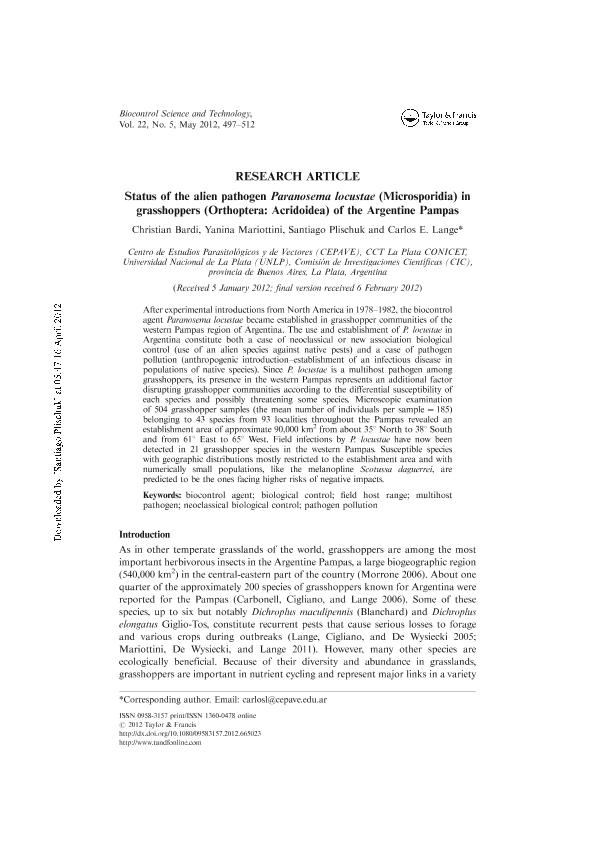Artículo
Status of the alien pathogen Paranosema locustae (Microsporidia) in grasshoppers (Orthoptera: Acridoidea) of the Argentine Pampas
Fecha de publicación:
05/2012
Editorial:
Taylor & Francis Ltd
Revista:
Biocontrol Science And Technology
ISSN:
0958-3157
e-ISSN:
1360-0478
Idioma:
Inglés
Tipo de recurso:
Artículo publicado
Clasificación temática:
Resumen
After experimental introductions from North America in 1978 1982, the biocontrol agent Paranosema locustae became established in grasshopper communities of the western Pampas region of Argentina. The use and establishment of P. locustae in Argentina constitute both a case of neoclassical or new association biological control (use of an alien species against native pests) and a case of pathogen pollution (anthropogenic introduction establishment of an infectious disease in populations of native species). Since P. locustae is a multihost pathogen among grasshoppers, its presence in the western Pampas represents an additional factor disrupting grasshopper communities according to the differential susceptibility of each species and possibly threatening some species. Microscopic examination of 504 grasshopper samples (the mean number of individuals per sample 185) belonging to 43 species from 93 localities throughout the Pampas revealed an establishment area of approximate 90,000 km2 from about 358 North to 388 South and from 618 East to 658 West. Field infections by P. locustae have now been detected in 21 grasshopper species in the western Pampas. Susceptible species with geographic distributions mostly restricted to the establishment area and with numerically small populations, like the melanopline Scotussa daguerrei, are predicted to be the ones facing higher risks of negative impacts.
Archivos asociados
Licencia
Identificadores
Colecciones
Articulos(CEPAVE)
Articulos de CENTRO DE EST.PARASITOL.Y DE VECTORES (I)
Articulos de CENTRO DE EST.PARASITOL.Y DE VECTORES (I)
Citación
Bardi, Christian Jorge; Mariottini, Yanina; Plischuk, Santiago; Lange, Carlos E.; Status of the alien pathogen Paranosema locustae (Microsporidia) in grasshoppers (Orthoptera: Acridoidea) of the Argentine Pampas; Taylor & Francis Ltd; Biocontrol Science And Technology; 22; 5; 5-2012; 497-512
Compartir
Altmétricas




